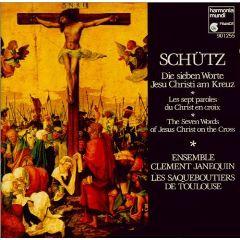Heinrich Schütz - The Seven Last Words of Jesus Christ on the Cross SWV 478 (1987)
Heinrich Schütz - The Seven Last Words of Jesus Christ on the Cross SWV 478 (1987)

1. Magnificat anima mea for soloists, 2 violins, 3 trombones & continuo, SWV 468 2. Erbarm Dich mein, O Herre Gott, for soloists, 2 violins, violone & continuo, SWV 447 3. Kleine geistliche Konzerte, Part 2, "Quemadmodum desiderat", SWV 336 4. Symphoniae Sacrae Book 1, Op 6, "Anima mea liquefacta est," a 4, SWV 263 & Symphoniae Sacrae Book 1, Op 6, "Adjuro vos, filiae Jerusalem" (2eme part), SWV 264 5. Ach Herr, du Schöpfer aller Ding, for soloists & continuo, SWV 450 6. Die Sieben Worte Unsers Lieben Erlösers for soloists, 5 instruments, continuo, SWV 478 7. Symphoniae Sacrae Book 2, No. 4, "Meine Seele erhebt den Herren" ŕ 3, SWV. 344 8. Die mit Tränen säen, motet for soprano & tenor voices, trombones & continuo, SWV 42 (Op. 2) (Psaumes de David) Ensemble Clement Janequin Les Sacqueboutiers de Toulouse Dominique Visse – Conductor
Compared with a genuine Baroque theatrical style, the Seven Words from the Cross is a paradox. This Historia ofthe Passion seems to be at the very opposite pole of the great BaroquePassions like the oratorios of the Catholic Counter-Reformation. On thecontrary, everything contributes to interiorise the Seven Last Words of Christi ina serene meditation which the music raises to the level ofcontemplation: “The Seven Words of Jesus on the Cross, keep them closein your heart”, the five voices sing in the exordium. The vision, soindividual, can only be interior. ---Jean-Pierre Ouvrard, harmoniamundi.com
Schütz never published "Die Sieben Wortte unsers lieben Erlösers und Seeligmachers Jesu Christi" as he did his Resurrection and Christmas Historias, and the work is known only in a set of performing parts whose connection to the composer is uncertain. We do not know whether the piece was intended for liturgical use in Dresden (though this is possible), and our only clue to its date is an inventory of music once found in Naumburg that evidently cites the piece; if the work listed is indeed Schütz's setting then the piece must have been composed before 1657/8, when the inventory was compiled. We do not know exactly how Schütz expected the work to be presented; the surviving set of performing parts represents one realization of the piece from the 17th century, but presumably was not the only possibility.
The text of the Seven Words deals with the passion story but it is not a narration of the crucifixion, nor does it present only one of the four gospels. Rather it is a compilation of Jesus' utterances from the cross drawn from all four evangelists, sometimes quoted one at a time and sometimes in combination. Each of the "words" has the same structure: Narrative material in the voice of an evangelist introduces the words of Jesus' direct speech, which are the high points of each section. (The second and last sections each add a brief narrative tag.) Schütz realized this structure musically by clearly distinguishing the two kinds of material, making an audible contrast between the narrated portion (evangelist) and the spoken words (Jesus).
Schütz distinguishes the narration from the quoted words by vocal scoring. Jesus' words are sung by the same tenor voice throughout, whereas the words of the narrator are sung by various other voices: soprano, or alto, or another tenor, or (in two cases) by a four-voice ensemble. That is, the voice of Jesus is associated with a particular singer but that of the evangelist is passed among three different voices, and even entrusted to a four-voice ensemble for the fourth (central) word and the last one. The constantly-changing narrating voice is less dramatically realistic than in Schütz's passion settings, but the changes in narrator help distinguish sections of the piece, which are more episodic than dramatically continuous - more a series of tableaux than a sequence of events.
Schütz also distinguishes the two kinds of text by musical style. The evangelist's words are presented primarily in narrative recitation that draws both on the traditional chanting of gospel texts and on theatrical recitative. The tendency towards recitation on one note over a static bass line is most clearly audible at the beginning of sections; as each develops, the narrator's vocal line tends to take more expressive turns. Jesus' words are set in a very different style entrusted to one singer in the texture of the modern vocal concerto, setting an expressive line against an independent basso continuo. The vocal lines in these sections, in contrast to the evangelist's recitation, are characterized by musical and textual repetition including so-called sequences, passages in which a small musical and textual idea is repeated successively at several pitch levels (rising or falling) for intensification. In fact, text repetition in the passages of direct speech, mostly absent in the narration, is among the most important differences and helps make the organization of the text clear. --- dacapo-records.dk
download (mp3 @320 kbs):
yandex 4shared mega mediafire zalivalka cloudmailru uplea








